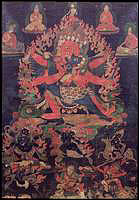
|
Tutelary Deity Hayagriva (painting no. 25)
|

View Larger Image |
||||||||||||||
|
Hayagriva in consort is central here. Above central sits the peaceful two armed Avalokiteshvara, of whom Hayagriva is a wrathful reflex. Lamas of the teaching and practice lineage fill the upper regions of the painting. Just below the main figures are the protectors Six-armed Mahakala, Lord of Death Yama, and Palden Lhamo (left to right). At the bottom of the painting we find the guardian and wealth god Vaisravana mounted on a lion and flanked by local protectors. M. Mokotoff 4-98 HAYAGRIVA, (Tibetan: tam drin, English: Horse Neck) from the Eight Sadhana Sections of Mahayoga Tantra of the Nyingmapa School. Wrathful, red in colour, with three faces, each with three large round staring eyes and cavernous mouths with sharp canine teeth, he has brown hair flowing upward and on top of the head is a small green horse head. The right face is white and the left green. With six hands the first pair hold a red lotus flower and skullcup while embracing the consort. The second hold a vajra hook, lasso and stretched human skin; the last pair of hands a stick and sword. Adorned with a crown of five dry skulls, earrings, gold and jewel ornaments, a necklace of heads and a tiger skin skirt, he is completely attired in wrathful charnel ground vestments and a set of vajra wings. The consort has one face and two hands, blue in colour, holding a skullcup in the left. Adorned in wrathful attire she wears a necklace of skulls and a leopard skin skirt. Standing with eight legs, the right bent and left straight, above two corpses atop a sun disc and multi-coloured lotus Hayagriva and consort dwell surrounded by the flames of pristine awareness. At the top center in the bodhisattva Padmapani Avalokiteshvara, white in colour, with one face and two hands. The right extended across the knee is in the mudra (gesture) of generosity and the left in the mudra of blessing at the heart; seated in a relaxed posture. To the left is Lama Tsongkhapa with the two hands in the teaching mudra and wearing a yellow pandita hat. At the lower left is the First Panchen Lama Lobzang Chokyi Gyaltsen with the right hand in the mudra of explication and the left holding a book in the lap. To the right is a lama attired as a monk and wearing a pandita hat. In the right hand he holds a vajra to the heart and with the left a bell in the lap. At the lower right a lama in similar appearance performs the earth touching mudra with the right hand and holds a vase in the left. At the bottom left is Sadbhuja Mahakala, black, with one face and six hands. Below is Kshetrapala, blue-black, with one face and two hands holding a curved knife and skullcup, riding a black bear. He is the main attendant to Sadbhuja. In the middle is Yama Dharmaraja with a buffalo head and two hands, riding atop a buffalo. Below is the protector of the northern direction, Vaisravana, with one face and two hands holding a victory banner and a mongoose, riding a white snow lion. At the right is Magzor Gyalmo holding a club in the right hand and a skullcup in the left, riding a mule. Below is Baiktse Chen, red in colour, holding a sword, heart and spear, accompanied by his consort and son. All of the protectors are surrounded by the flames of wisdom fire. Arising from the Mahayoga division of the Inner Tantras, Hayagriva belongs to the set known as the Eight Sadhana Sections. From the two types of Buddhist teaching transmission, Transmitted Precepts and Revealed Treasure (terma), this form of Hayagriva belongs to the latter. Both forms were received, discovered and taught by Arya Nagarjuna. The Terma text was procured from a copper casket in the Shankarakuta stupa at the charnel ground of Sitavana near the present day Bodhgaya in Northern India. Jeff Watt 10-98
|
|||||||||||||||
Photographed Image Copyright © 1998 Shelley & Donald Rubin Foundation
|
|
| |
Next Image |